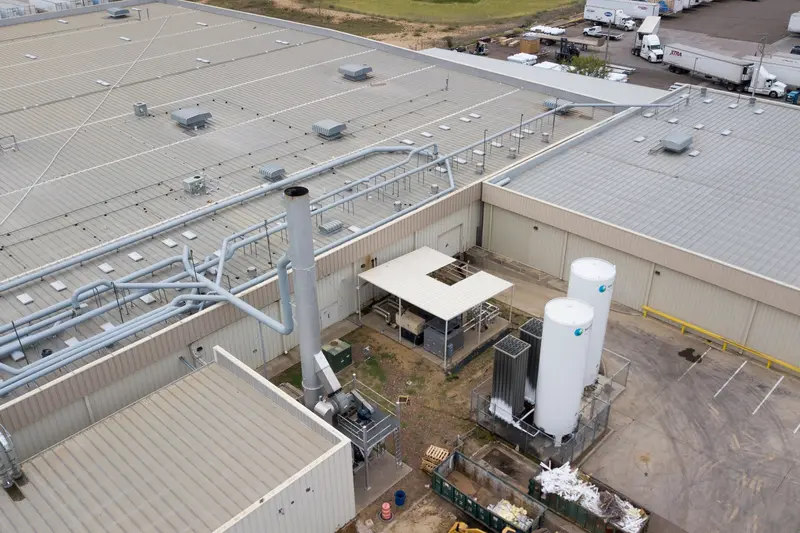Lisa Song and Maya Miller contributed reporting.
New EPA Rule to Slash Cancer-Causing Emissions From Sterilization Facilities
“Salmon Wars,” produced by ProPublica and OPB, tells the story of one Yakama Nation family who has spent generations fighting for salmon. The series uncovers who is to blame for the fish vanishing and why their disappearance affects all of us.

The U.S. Environmental Protection Agency on Thursday issued a rule to slash toxic emissions from commercial sterilization facilities that have posed an increased lifetime cancer risk to residents who live near them. These facilities release fumes of ethylene oxide, labeled by the agency as “one of the most potent cancer-causing chemicals.”
Ethylene oxide, a flammable, colorless gas, is used to sanitize medical and dental equipment to reduce the risk of infection, and fumigate certain food products. Long-term exposure to ethylene oxide can cause irritation of the eyes, skin, nose and throat as well as damage to the brain and reproductive system.
The new rule will place stricter limits on how much ethylene oxide commercial sterilizers can release into the outside air, eventually eliminating about 90% of emissions of the gas nationwide, according to the EPA. An analysis by the environmental group Union of Concerned Scientists found about 13 million people live near these facilities, and these emissions pose a disproportionate risk to poor and minority communities. In Texas, residents say a plant in Laredo, Midwest Sterilization Corporation, has contributed to the city’s elevated rates of cancer.
Facilities would be required to install pollution-control equipment, conduct continuous emissions monitoring and file quarterly reports to the EPA. A spokesperson with Midwest Sterilization told ProPublica the company is evaluating the new rule and learning about its requirements. “Our top priority is ensuring we can continue to keep communities safe while helping to save patient’s lives,” the spokesperson wrote, referring to the corporation’s work on sterilizing surgical kits for hospitals.
Reducing cancer in communities exposed to toxic air pollution has been a prime focus of the Biden administration’s environmental agenda. The new rule will address emissions at nearly 90 commercial sterilization facilities, including some in Texas, that are owned and operated by approximately 50 companies.
Prior regulations on commercial sterilizers that use ethylene oxide did not account for the EPA’s latest research. In 2016, the agency concluded that ethylene oxide was 30 times more carcinogenic for adults than previously thought and 50 times more carcinogenic for those who are exposed since birth.
“We have followed the science and listened to communities,” EPA Administrator Michael Regan said in a press release. “We’ve arrived at a historically strong rule that will protect the most exposed communities from toxic air pollution while also ensuring that there will be a process that safeguards our nation’s critical supply of sterilized medical equipment.”
A 2021 investigation by ProPublica and The Texas Tribune revealed the EPA’s yearslong failure to inform communities, including Laredo, a city of more than 250,000 on the Texas-Mexico border, of the risks they faced from the cancer-causing chemical. The Texas Department of State Health Services conducted two assessments in 2022 examining cancer rates from 2006 to 2019 in Laredo and found a higher rate of acute lymphocytic leukemia, breast cancer and non-Hodgkin lymphoma compared with cancer rates elsewhere in the state.
“We were completely unaware. And to this day, I think many still are not fully aware of what’s right there and how dangerous this chemical is,” said Tricia Cortez, a Laredo resident and executive director of the environmental nonprofit Rio Grande International Study Center, on Thursday.
“The ones who suffer most are our everyday people who live and work right next to these facilities.”
Cortez said that her community has been waiting a long time for EPA’s new rule and that the decision to reduce emissions means a lot.
In 2022, Earthjustice sued the EPA on behalf of environment and community groups including the Rio Grande International Study Center for not updating the rules in nearly a decade and leaving communities unaware of the risks. (The lawsuit is still ongoing.)
Following news reports, the EPA published proposed requirements last year to reduce ethylene oxide at these medical sterilizers. The agency conducted public hearings, webinars and meetings to hear from communities and their health concerns. It also published an analysis of the industry’s self-reported emissions data that showed about a quarter of the nearly 100 commercial sterilizers, including the one in Laredo, were exposing nearby residents to unacceptable cancer risks from ethylene oxide. The agency also published risk maps and other information online for each of the high-risk facilities.
“Overall, I am pleased this rule will protect the health of communities while still considering the importance of medical sterilization devices to hospitals, doctors, and patients,” said U.S. Rep. Henry Cuellar, D-Laredo, in a press release.
Scott Whitaker, president and CEO of the Advanced Medical Technology Association, a group that lobbies for the interests of medical device manufacturers, said in an email on Thursday the group is still examining the new rule’s full impact, but he warned that new regulations could cause problems for patients by creating treatment and surgical delays.
“There are three broad areas we have emphasized throughout the rulemaking: adequate time to implement, flexibility in technologies to remove emissions, and the ability to achieve EPA targets that would not force resubmission of medical devices for FDA approval,” Whitaker wrote.
EPA is assuring the medical industry that these new rules will not impact access to sterilized medical equipment. Harold Wimmer, president and CEO at the American Lung Association, praised the federal agency for striking a balance between new measures for limiting pollution and the need for safe and clean medical supplies.
“No one should have to live with elevated cancer risk because of air pollution in their community,” Wimmer said in a press release.
The new rule will evaluate if facilities are complying based on their cap or allowable amount of emissions they can release into the air per pollutant as listed in their state permits.
“What we know is that these facilities are often releasing more than what they are stating. [The EPA] revised its risk assessment to look at how much a facility is allowed to emit and as a result is more stringent standards, which we think is a major positive,” said Marvin C. Brown IV, a senior attorney at the nonprofit Earthjustice.
In response to questions from ProPublica, Brown said that the news organizations’ joint investigation into industrial emissions and cancer risk played a role in the final rules. “I think it has led to people commenting, participating in the process, pushing EPA to do this and to regulate this industry in a way that will hopefully save a lot of lives in the future,” he said.
While Brown sees the EPA’s new rules as a great first step, he said he was disappointed to see that the agency did not end up requiring commercial sterilization facilities to obtain Title V permits. The agency had included this stipulation in its proposed rule last year, which would have mandated that facilities undergo a permit approval process that includes a review from federal regulators in addition to state regulators, and federal requirements for public participation.
The rules go into effect shortly after they are published in the Federal Register. Facilities will have two years to install monitoring and pollution controls and an additional 180 days to demonstrate compliance. If facilities need more time, they can petition states and the EPA for an extension.
In the past, the state’s environmental regulator, Texas Commission on Environmental Quality, has disagreed with the EPA’s science assessment of ethylene oxide’s dangers to health and the environment. The TCEQ launched its own review of the chemical in 2020, which ruled that it was significantly less toxic than the federal agency had found. The TCEQ attempted to enact a new standard that could allow plants to emit more of the chemical, but the EPA rejected it in 2022.
Richard Richter, a spokesperson for the TCEQ, said the agency will implement the new standard and facilities will be required to comply with the new rule.
ProPublica is a nonprofit newsroom that investigates abuses of power. Sign up to receive our biggest stories as soon as they’re published.
This article is co-published with The Texas Tribune, a nonprofit, nonpartisan local newsroom that informs and engages with Texans. Sign up for The Brief Weekly to get up to speed on their essential coverage of Texas issues.
ProPublica is a nonprofit newsroom that investigates abuses of power. Sign up to receive our biggest stories as soon as they’re published.
This article is co-published with The Texas Tribune, a nonprofit, nonpartisan local newsroom that informs and engages with Texans. Sign up for The Brief Weekly to get up to speed on their essential coverage of Texas issues.
Lisa Song and Maya Miller contributed reporting.
Lisa Song and Maya Miller contributed reporting.







